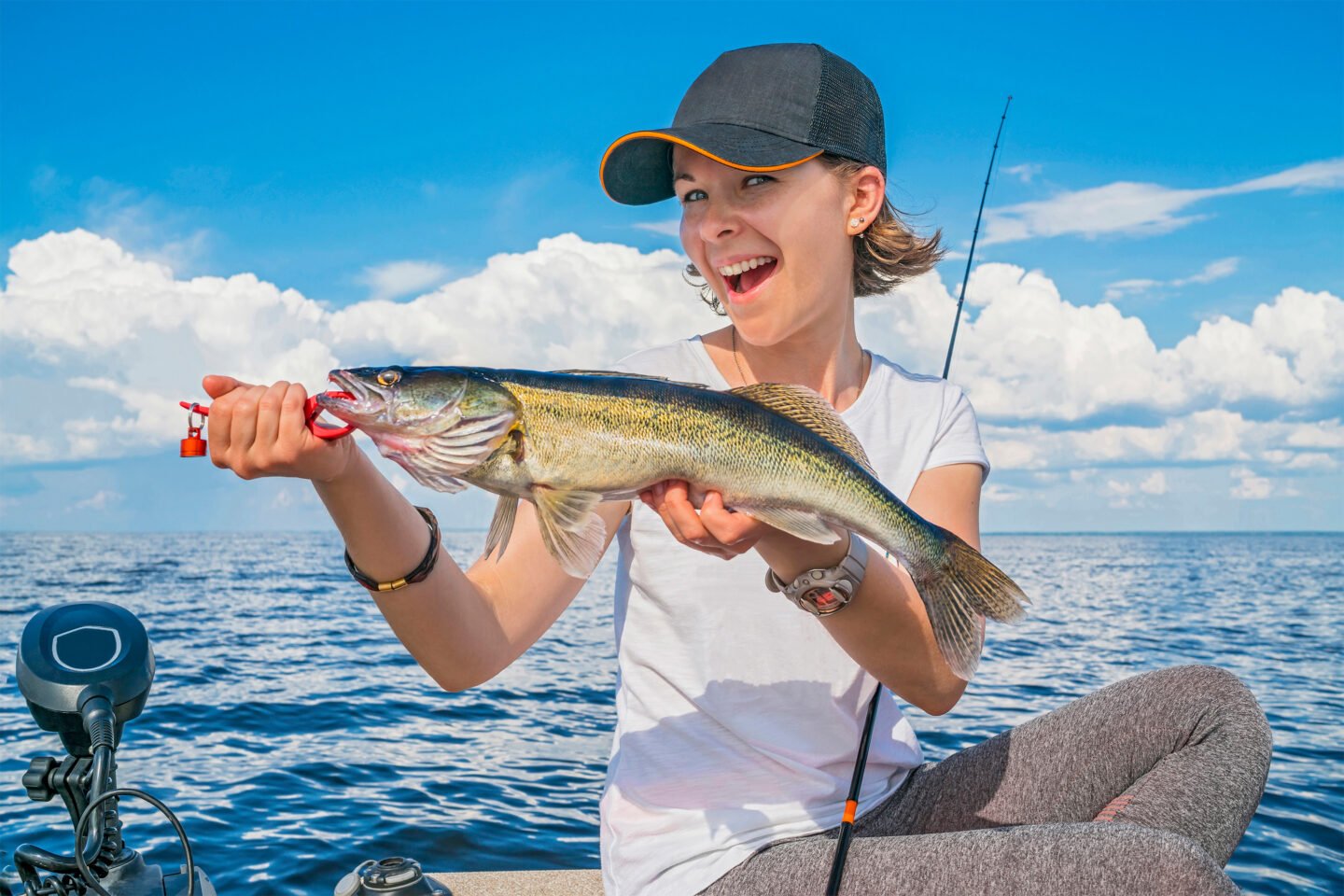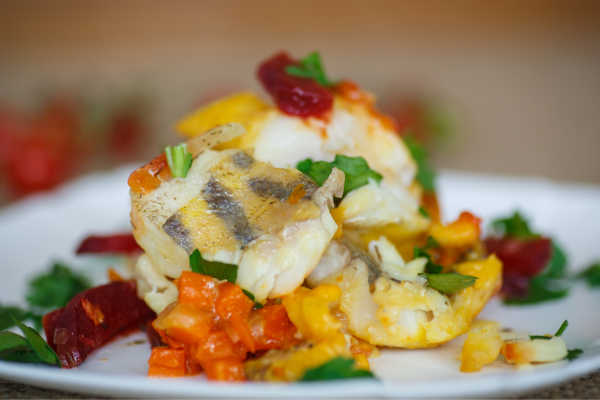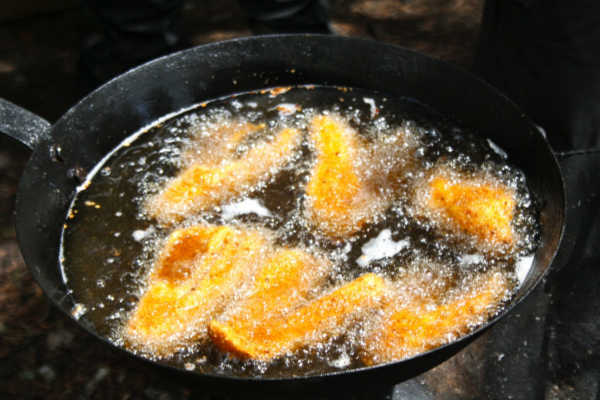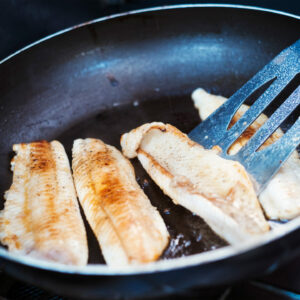Walleye is a member of the perch family found in the streams and lakes of the United States and Canada. It is showing up increasingly on restaurant menus as a high-end menu item. So what does walleye taste like? Is it worth buying, or are more common varieties like salmon and red snapper a better option? Let’s dive in and find out.

Table of Contents
Walleye Taste
Walleye is a freshwater fish that is well regarded for its unique taste. The fine-flaked fillets offer a subtle, sweet flavor with low levels of fishiness. Its texture is firm yet delicate with a buttery mouthfeel.
There are relatively few bones, and this is likely to be popular with almost everyone. Each fillet is thick and offers a good-sized portion that, when cooked right, is lovely and moist inside — a vibrant shade of pink when raw, Walleye changes to white once cooked.

| Fishiness | Oiliness | Texture |
|---|---|---|
| Mild | Low oil content; a light fish | Firm yet delicate and moist |
Quick facts
- Other common names for the walleye include dory, freshwater perch, pickerel, pike-perch, yellow walleye, yellow pike or the walleye pike.
- Walleye fish are named for their cat-like eyes, which are highly reflective.
- Although they’re found in Canada and the U.S., the only commercial fisheries are in Canada due to concerns of over-fishing.
- Although the standard size of walleye in restaurants can be up to 5 pounds, they can grow to 20 pounds in the wild.
Best substitutes
If your recipe calls for walleye, but you’re unable to get your hands on any, some good alternatives include yellow perch, snapper or grouper. Although not precisely the same, they are good backup options. Keep In mind that these are seawater fish so they’ll have a more pronounced flavor of the sea. Walleye, being freshwater, has more of a bland taste.
What flavors complement walleye?
Seasoning
- Lemon pepper
- Garlic
- Black pepper
- Paprika
- Basil
- Cumin
Sides
- Onion rings
- Potatoes
- French Fries
- Coleslaw
- Garden salad
- Sautéed vegetables
Wine
- Moscato
- Pinot Gris
- Sauvignon Blanc
- Champagne
- Pinot Noir
- Riesling
Comparing walleye to other common fish
With some of the fish in the below table, there isn’t a huge amount of difference. We’ve compared their habitat, taste, and texture for quick reference.
| Fish | Habitat | Taste | Texture |
|---|---|---|---|
| Walleye | Freshwater | Subtle, sweet flavor with low levels of fishiness | Firm yet delicate and moist |
| Trout | Freshwater | Tastes mildly nutty and delicate with low levels of fishiness | Firm, moist texture similar to walleye |
| Cod | Fresh or saltwater | Mild, savory flavor with low levels of fishiness if it is fresh | A large flake that's lean and firm |
| Northern Pike | Freshwater | Stronger, fishier tasting than walleye with more bones | A firmer texture than walleye |
| Halibut | Saltwater | Mild tasting slightly sweet-flavored flesh | Lean, large flaked texture |
| Catfish | Fresh or saltwater | It can be muddy tasting. Wild catfish are fishy, farmed are sweet and mild | A moist texture that quickly becomes rubbery if overcooked |
| Grouper | Saltwater | Light sweet taste, similar to crab | A firm texture and large flakes |
Nutrition Information: 3oz (85g) Walleye
| Calories | 68.9 |
|---|---|
| Protein | 14.6g |
| Total fat | 0.7g |
| Saturated Fat | 0.1g |
| Cholesterol | 60.4mg |
| Sodium | 84.1mg |
| Omega 3 | 329mg |
Tips to help you buy the best fish
- Don’t use the eyes for testing freshness. With most fish, the eyes are an excellent way to decide if the fish is fresh. Walleye is different as it has opaque, flat eyes even when freshly caught.
- Look at the skin to determine the freshness. It should look firm and shiny, not dull.
- To check for quality fillets, look for moist flesh that looks like it’s been freshly cut. Avoid fish with a pungent or overly fishy smell.
How to fillet a walleye
How to Cook Walleye
Walleye is a versatile fish that can be prepared in a few different ways. Smoked, broiled (grilled), pan-fried, baked, poached, or used in chowder; they’re all simple, delicious options. The subtle flavor of the fish should be respected – too much spice and heavy sauces will over-power the seafood.
Keeping a close eye on the cooking time is essential as overcooked walleye is rubbery and unpleasant.

Recipe: Pan-fried fish

Pan Fried Walleye Fish
Ingredients
- 4 walleye fillets
- 5 Tbsp canola oil
- ¼ cup butter
- 3 sprigs fresh thyme
- 2 Tbsp flat-leaf parsley chopped
- salt and pepper to taste
- lemon wedges
Instructions
- Using paper towels, pat the fillets to ensure they’re dry, then season with salt and pepper.
- Heat a large skillet over high heat until hot, then add oil. Add the fish, reduce the heat to medium, and cook for around 2 minutes. The fish will be nicely browning on the bottom when it’s time to turn it.
- Flip the fish, then add the butter and thyme to the pan. Scoop the melted butter and herbs onto the fish for about 1-2 minutes until cooked through. The fillet should appear golden on the outside with an appetizingly moist, white interior.
- Sprinkle parsley over the fish and serve immediately with lemon wedges.
Notes
- If your fillets have skin on, then place the fish skin side down when adding them to the frying pan.
- Gently push down on the fish with a fish slice for 20 to 30 seconds to stop the fillet from curling up.
- Cooking times for fish will vary depending on the thickness of the fillets, so use them as a rough guide. It is best to frequently check the progress by sight rather than relying on cooking times.
- Fish continues to cook after removing it from the pan, so stop cooking a little before it’s ready.
Nutrition
Related reading:
What does sea bass taste like? Get the facts.
White perch vs. white bass - what is the difference?
How to Reduce the Fish Taste of Walleye
The best option is to catch the fish yourself or get it from a reputable seller. Fishiness increases as the fillets age.
For a milder tasting fish, pour half a cup of vinegar into a bowl and add the fish. Mix it thoroughly to completely coat the fillets then transfer the fish to a tray or dish. Refrigerate for 30 minutes and allow the vinegar to absorb. The result will be a fish with less fishy flavor.
Final Words
Walleye offers a fine-flaked fillet with a subtle, sweet flavor and low levels of fishiness. A good fish if you enjoy eating a meal consisting of mild flavors. Its texture is firm yet delicate with a buttery mouthfeel. If you prefer less fishy, blander tasting fish then you’ll probably enjoy it. Cooking technique will significantly affect the texture; choose recipes that don’t overwhelm the meat with too much flavor. But most importantly, watch the cooking time - a little overcooked and the final result won’t be pleasant.
When choosing a freshwater fish, I prefer a walleye over a catfish which is often muddy tasting or the northern pike which is fishier. If you prefer food caught from the sea then you’d be better to stick with more common options such as salmon or cod.
If you prefer fish with a little more flavor, check out our review of what eel tastes like and decide whether anchovies or sardines are the best option for your next meal.
What’s your favorite cooking method that’s easy for beginners cooks? Let me know in the comments below.
References
1. https://web.archive.org/web/20210926030419/https://fws.gov/fisheries/freshwater-fish-of-america/walleye.html
2. https://nutritiondata.self.com/facts/finfish-and-shellfish-products/4226/2

Leave a Reply